Marketing Never Stops
Many of us, these days, own and run one-person businesses. Even when we do great work, solo business success is a challenge.
- When we start the business, if our marketing doesn’t work, we may run out of money before we even really get going. So effective, affordable marketing is key.
- When we’re successful, we’re so busy doing work for existing customers that we feel we have no time to market. That begins a boom-and-bust cycle. When we finish the current work, nothing new comes in the door, and we rush to market ourselves before the money runs out.
- If we run into a roadblock for any reason (personal illness, family crisis, a big customer who doesn’t pay his bill), we can end up in a jam. We may need the results of marketing before we can pay for it, do it, and give it time to work.

These are simple facts of the day to day life of a one-man or one-woman business. And they lead to one lesson.
Lesson #1: Marketing never stops.
We market our business before it launches. We market our business when we are busy. We market our business when we have no money. Our marketing changes as we invest more or less money or time on it, but our marketing never stops.
How I Became an Expert in Small Business Marketing
When I launched my own business in 1993, I was very lucky. I would have been out of business in a year if I hadn’t gotten a contract to travel all over the country and teach computer professionals. (I was a PC computer geek back then.) I got the contract, and it lasted eight years. The great thing about is that I was getting paid a lot of money to teach, that is, to stand up in front of people and show them how much I knew about solving their problems.
I was actually being paid to market myself. I got hired as a consultant or trainer straight out of the class. A student would walk up, hand me a business card, and say, “I’ve got a problem.”
Over the course of a few years, I actually made several hundred thousand dollars following up on leads created just by having students in my classes call me.
For eight years, I got a free pass on marketing my business.
Then that contract ended, and I had to face reality. And I truly didn’t know what to do.

I knew two expert sales trainers. They checked me out and told me I was an excellent salesman. So that wasn’t the problem. If I met someone interested in what I had to offer, I could close the deal. I began to read – a lot. I started with the basics. To be honest, I didn’t even have a good idea what marketing was.
I learned, and I learned fast, as I watched my bank account dwindle. In one sentence, here is what I learned.
Lesson #2: Marketing is what we do to find our prospective customers and get them in the door; sales is what we do once a specific prospective customer is talking to us, until we close the deal; after that, it’s customer service.
I was already good at sales and customer service. I just had to get people in the door!
Figure #1: The Marketing Funnel
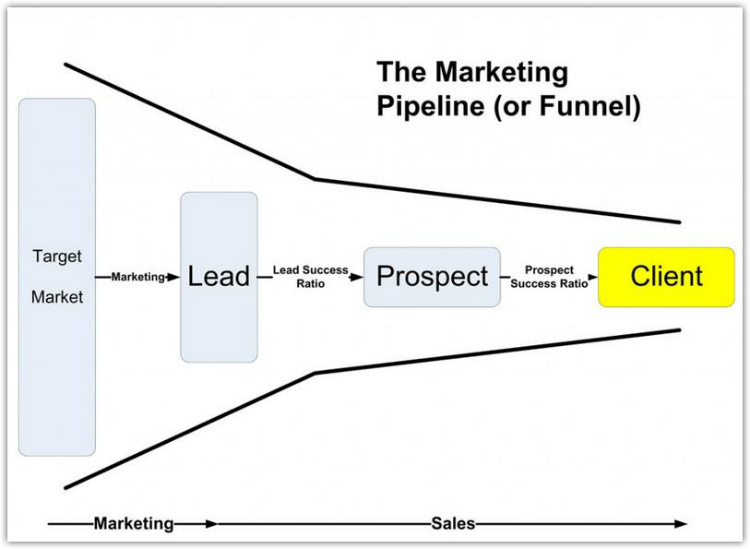
Marketing and Sales move prospective customers in your target market into being actual customers, appreciating your services and paying you money.
The Marketing Funnel
Think of marketing as a big machine, kind of like a giant vacuum cleaner. At the front end are people who might buy your product or service. Marketing sucks them into the funnel.
But the funnel gets smaller and smaller. Some of those people would not really benefit from what you have to offer. Others don’t have enough money to afford it. Others just can’t make a decision right now. Some just don’t know what’s good for them. So we need a lot of prospective customers coming in to get just a few paying clients.
I said a marketing funnel is like a giant vacuum cleaner. You’ll see a picture of the marketing funnel in Figure #1. And you’ll see a comparison table explaining the problems in marketing by comparing the marketing funnel to a vacuum cleaner in Table #1. Please take a look at these and come back to learn the next big lesson.
Table #1: Good Marketing is Like a Vacuum Cleaner
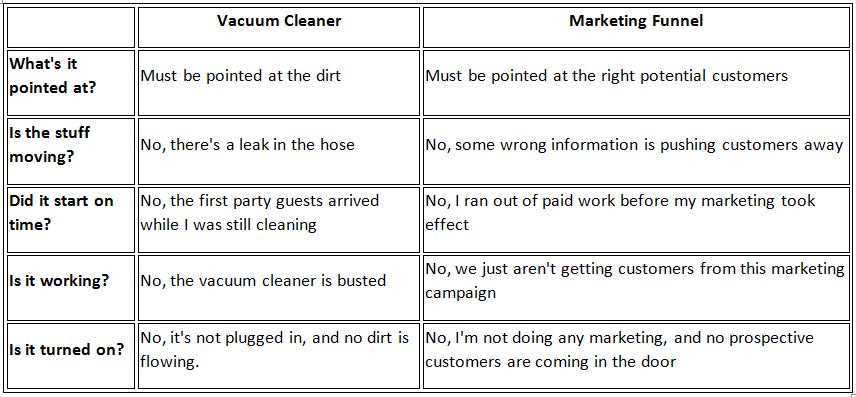
Build Your Own Marketing Funnel
Lesson #3: You must build, maintain, and use your own marketing funnel, unique to your business.
So, let’s talk about how to do that. The key is that a marketing funnel is a whole machine. It’s got to be designed right, and it’s got to be built right, and it’s got to be run right, or it just won’t suck in the customers. That’s what this whole article is about. Here are the crucial points:
- What we have to be clear about before we can start
- Marketing design ideas independent of what marketing tools we use
- Marketing methods: Planning; Publicity; Promotion; and Advertising
- Marketing tools: The Basics; Internet marketing tools; and Local marketing tools
There’s a lot to learn here, and this overview can only introduce each topic. Keep an eye out, as I’ll be writing more in times to come. And I want to recognize the small business marketing specialists who helped me out the most: Robert Middleton and Jeanna Pool. I’ll be telling you more about them, soon, too.
At the end of this article, I’ll show you how to figure out your next step to marketing success.
Basic Assumptions – Let’s Clear the Air
A lot of marketing is hype, and even downright dishonest. I’m here to help honest people succeed by doing good things for other people. So, here are my assumptions.
You Don’t Suck
Even though I compared your marketing funnel, to a vacuum cleaner, I’m not saying you suck. I’m assuming:
- You are good at what you do
- that your products and services genuinely help your customers, giving them what they want or need
- that you are, and want to be, honest
Now, we’ve never met, so I don’t really know that any of my assumptions are true. Let’s say, just for purposes of discussion, that a con artist is reading this article. She doesn’t need my services. She can make a lot more money with dishonest advertising than I can make with honest advertising. And that’s okay. In fact, most TV commercials include dishonesty and manipulation. Many billboards promise things that the company can’t offer.
But, if you’re in for the harder job – honest business that provides real value – with honest marketing. Congratulations! You’re business will make things better for your customers, and together we’ll make the world a better place, and make good money doing it. I’m right here with you!
Your Customers Aren’t Suckers
There’s a saying, “there’s a sucker born every minute,” attributed to P. T. Barnum, but probably originating with a different marketing guru or con artist.
Let’s say that’s true. It doesn’t mean that everyone is a sucker. Far from it. In 2011, 256 people were born every minute. If P. T. Barnum is right, then there are 255 people who are not suckers born every minute. Those are your customers. The one other guy or gal, the sucker, can give money to the con men and get nothing for it.
Honest Marketing for Good Business
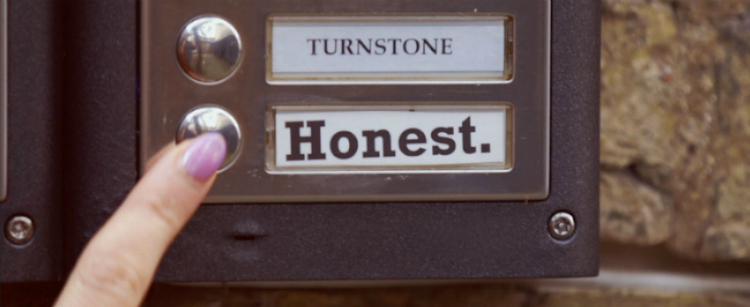
The bottom line here is to make your bottom line grow with honest marketing for good business. It isn’t easy. I’m not sure it was ever true, what Emerson said, “Build a better mousetrap and the world will beat a path to your door.” Or maybe it was true before the invention of scientifically designed, psychologically manipulative advertising.
But it isn’t true anymore. Now, with all the noise, hype, and con games out there, our honest customers won’t trust us until we build that trust. So we’ve got a lot of work to do to build effective marketing.
Lesson #4: Good, honest marketing is hard. In the end, though, it’s all worth it: We make a great living doing great things for great customers.
Marketing Concepts and Design
Many small business owners get caught up by all the hype about Social Media and think, “I have to market on Facebook,” or “I have to do mobile marketing.” Now, that may actually turn out to be true. But a bad marketing campaign on Facebook or Twitter won’t do you any good at all. The fundamentals of marketing have not changed because they are based on the fundamentals of human psychology. They’ve worked for at least three million years, and won’t change soon, iPod or no iPod.
Applying the classic marketing model to small business, we see that, whatever tools we use, marketing consists of these steps:
- Target Market Identification: identifying the people or businesses who will genuinely benefit from our products and services.
- Getting the Word Out: Make our target market aware that we are here, and able to help.
- Sparking their interest, so they connect with us to learn more.
All the steps after that are part of sales, which is the next step after marketing.
Target Market Identification
We begin identifying our target market by getting clear about whether we are business that serves other businesses (B-to-B), or a business that serves individual consumers or customers (B-to-C). The way to define B-to-B customers is very different than the way to define B-to-C customers. Both processes involve asking a lot of questions and doing good research to find out:
- Who are our customers?
- Demographics: Where are our customers?
- Psychographics: What motivates our customers? Also, what turns them off?
- What do our customers think they want? What do they really need?
- What is the best way to meet our customers, or advertise to them?
- How do our customers make decisions? What can we provide to get them interested?
Getting the Word Out
This is discussed more in the next section, Marketing Methods.
Sparking Interest in Our Customers
People make decisions as much, or more, on an emotional basis as on a rational one. We have to meet that fact head-on. Our research must be analytical, but our marketing campaign must be creative, emotional, and motivational. Our goal is to create an exciting campaign that brings our prospective customers in. The analysis is about finding those customers and understanding them. The creative part is getting their attention and getting them interested – no – make that excited!
Figure #2: The Foundation and Pillars of a Small Business Marketing Campaign
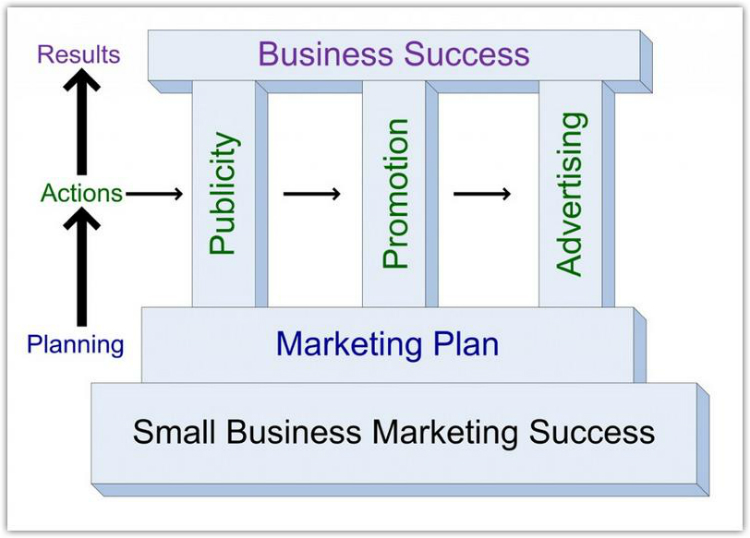
Begin by writing a marketing plan, then engage in publicity, promotion, and advertising to achieve business success.
Selling Binders All the Way Into a Bind
I was speaking to a prospective client. His company was in serious financial trouble. The company made and sold custom binders, that is, 3-ring binders with specially imprinted covers. Their biggest clients were churches and corporations.
He was spending $4,000 per month on Google pay-per-click advertising. Unfortunately, his choice of ad words was bad. People who wanted one binder, or ten, would click on his ad. But he only sold batches of 100 or more custom-made binders. So, he was paying lots of money, but his marketing machine wasn’t reaching the right customers.
I recommended that he stop the pay-per-click campaign and then spend half the cost per month on my marketing consulting. I knew that, following the small-business marketing methods we’re talking about here, we could point his marketing funnel at his real customers and save his business. But he was too afraid. He was lost in an illusion of hope: Maybe that one big click would come through. He wouldn’t stop the ad campaign, even though it was draining money every month.
Before he changed his mind, the money ran out, and a two generation family business – and the family fortune – were gone forever.
Marketing Methods: Planning, Publicity, Promotion, and Advertising
Now we look at the foundation and the pillars of our marketing campaign, as shown in Figure #2.
The Marketing Plan
Creating a market plan includes defining the target market, as we discussed above. But it also includes choosing our methods and building a budget and a schedule.
Publicity
Publicity, or an ongoing public relations (PR) campaign, is a great way to get free advertising. PR is not only local; there are now web-based tools such as PRWeb.
Promotion
Promotion is all the things that we do to get ourselves known and get people interested in working with us. Practically, this falls into four categories:
- Professional Appearance. Basic things like being well-groomed, just in case the next person we bump into is a new customer, and always having a business card with us. The Internet version of this is an attractive presence on Facebook and our web site, and good links for customers to follow to find us.
- Marketing as we work. Our work shows other people what we can do.
- Networking. Making contacts and reaching out.
- Giving to get. Many activities following the givers gain principle.
See Table #2 for local and Internet examples of each of these.
Advertising
Advertising costs money. As a result, it is often the wrong choice for the one-person business. Large businesses succeed through a lot of advertising, but they spend big bucks, and they do a lot of research and experimentation. That means that a lot of ad campaigns fail. Most solo business owners can’t burn that kind of money. But sometimes, advertising is the right choice. When it is:
- We want to do all of our target market research, planning, and budgeting up front.
- We want to decide on what advertising to try.
- We want to track expenses and resulting sales closely.
- We want to develop small experiments, then go with what works.
Table #2: Promotional Methods: Local and Internet Examples
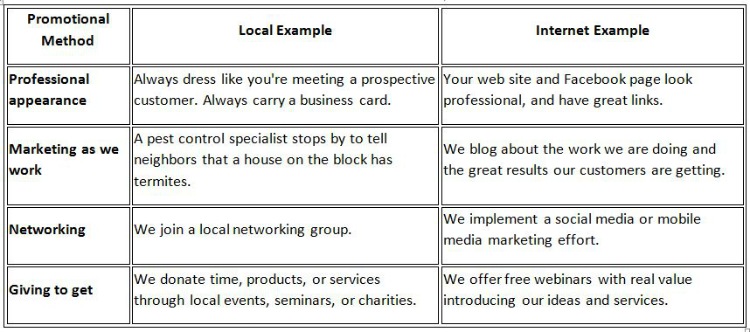
Local and Internet Marketing Tools
If you’ve made it this far, congratulations! Now it’s time to choose your marketing tools.
How to choose the right tools
There are literally dozens of tools, methods, and programs to choose from. Here are some key points:
- Do the basics first. Get your corporate image, web site, business cards, and stationary all lined up.
- Make your choices based on your plan, and on what has worked in the past. For example, many small businesses succeed on referrals. If that’s true for you, don’t run off and do something else. Turn your referral system into a true marketing machine.
- Choose at least three different marketing methods to develop, so you don’t run dry if one or two quit working for a time.
- Don’t choose more than six marketing methods. A solopreneur will get too scattered and fail at that point.
- Eliminate what doesn’t work for you. Maybe you’ve heard “every business needs an ad in the yellow pages.” But if you’re not getting business from a yellow pages ad, then stop it. That wasn’t true for you. (It was just hype from the folks at YP!)
- Be willing to try something that didn’t work in the past.
- Learn as you go. Track your results with lots of small experiments.
I want to thank Jeanna Pool, author of Marketing for Solos for these great tips.
Tools to Consider
Here is a short list of tools to consider, broken out into classic and Internet marketing tools.
Classic (and Local) Marketing Tools
- Basic. Business cards, letterhead, professional attire and grooming, brochures
- Marketing as we work. Putting a sign on our truck or our car; following up for testimonials and referrals from existing clients.
- Networking. Joining a local networking group, such as BNI.
- Direct marketing. Mail and telephone campaigns.
- Giving to Get. Giving lectures. Donating products or services to charities for raffles.
- Advertising. Yellow pages and Chamber of Commerce or local newspaper and magazine ads.
Internet Marketing Tools
- Basic. Web site; Facebook page; Twitter presence.
- Marketing as we work. Blogging.
- Networking. Writing and commenting here on HubPages. Daily activity on Facebook and Twitter.
- Direct marketing. email blasts; mobile marketing campaigns.
- Giving to Get. Promote special discounts.
- Advertising. Google Adsense and Google +.
This is all way too much to choose from. TMI (Too Much Information!) MEGOHA (My Eyes Glazed Over Hours Ago!)
I hear you, loud and clear. The hard fact is that all of this is necessary. Successful marketing for your business is a complicated machine. Honestly, I’ve made it as simple as I can. If I made it any simpler, I’d leave out a crucial piece, and your marketing campaign would be a waste of time and money.
Take this ONE STEP at a time. You can do this. (How do you eat an elephant – with a steak knife, one bite at a time.) Let’s step back and figure out your next step.
Your Next Steps to Marketing Success
Are you desperate for a marketing solution right now? I hope not. But, even if you are, don’t skip the planning. Marketing without planning is, quite simply, throwing away money.
So:
- If you haven’t defined your target market thoroughly, that is your first step.
- If you have a good target market definition, then setting up a marketing plan with a schedule and budget is next.
- If you have a plan, then take care of the basics: Professional appearance; business cards and brochures; web site.
- If you have the basics, but have no other marketing going, pick one method and go for it. Then, add two more.
- If you have the plan and the basics, and your current marketing isn’t working, work on making it better. Evaluate the method. If it should work for your target market, figure out what’s broken, and fix it. If it can’t work for your target market, throw it away and try another method.
The Science of Marketing
The purpose of marketing is to bring back returning customers and bring in new customers. And these customers need to buy what you are selling in a way that ensures that you are making more money than you spend on marketing. If you follow the ideas in this article, you’ll be on your way. But be careful. Marketing often means reaching a lot of customers to get just a few customers. One little glitch in your marketing machine can mean that you are losing money, instead of making it.
At that point, we have to go beyond planning to genuine engineering. You will want to track actual marketing results. You will want to experiment with different methods and images, and see what works. You will want to keep doing what works, and improve what is almost working, and drop what is not working. And, as things change over time, you’ll need to keep trying new things.
This experimentation is essential, and it pays off. With it, we build a reliable marketing funnel that works just right for our business. We get more customers using less time and at lower cost, which means we can focus on serving our customers. Whenever a new customer comes in, or, even better, when an old customer comes back, we have a chance to help him or help her, and make money doing what we love to do.
That’s what being a small business owner is all about.
About Author: Juan Koss is an MBA graduate and startup enthusiast. He is the creative head behind Write My Essay For Me company. His passion for finding creative strategies to convey complex ideas has manifested itself in more than seven years of successful business experience.


